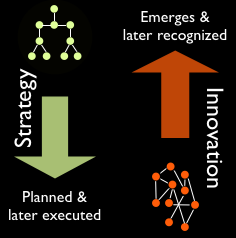As networked social applications mature, they’re evolving more nuanced ways of constructing and maintaining an identity. Two of the major factors in online identity are How you present yourself, and Who you know.
How you present yourself: “Flourishing”
Flourishing is how we ornament ourselves and display ourselves to others. Think of peacocks flourishing their tail-feathers. It’s done to communicate something about oneself — to attract partners, distinguish oneself from the pack toward some end, or even dissuade the advances of enemies.
I don’t know if this behavior has another name, or if someone else has called it this yet. But it’s the best name I can think of for the technologically enhanced version of this behavior.
Humans have always used personal ornament to say something about themselves, from ancient tattoos and piercings, “war paint,” various kinds of dress, engagement and wedding rings, to larger things like their cars and homes. We’ve long used personal ornament to signal to others “I am X” in order to automatically set initial terms of any conversation or encounter.
It expands our context, and makes physical things about us that our bodies alone cannot communicate. Often these choices are controlled overtly or subtly by cultural norms. But in cultures where individual identity is given some play-room, these choices can become highly unique.
So, how has digital networked life changed this behavior? For a while, I’ve thought it’s fascinating how we can now decorate ourselves not only with things we’ve had to buy or make, but with a virtual version of almost anything we can think of, from any medium. My online identity as represented by one or more ‘avatars’ (whether that’s an avatar in an environment like Second Life, or a MySpace profile that serves a similar, though 2-D purpose) can be draped with all manner of cultural effluvia. I can express myself with songs, movie clips, pictures of products I love (even if I can’t afford them). Our ability to express ourselves with bits of our culture has increased to vertiginous heights.
Just as I started blogging about this thing that’s been on my mind for a while, I thought I’d look to see if anyone has done real work on it. I’m sure there’s a lot of it out there, but one piece I ran across was a paper from Hugo Liu at MIT, entitled “Social Network Profiles as Taste Performances,” which discusses this development at some length. From the introduction:
The materials of social identity have changed. Up through the 19th century in European society, identity was largely determined by a handful of circumstances such as profession, social class, and church membership (Simmel, 1908/1971a). With the rise of consumer culture in the late 20th century, possessions and consumptive choices were also brought into the fold of identity. One is what one eats; or rather, one is what one consumes—books, music, movies, and a plenitude of other cultural materials (McCracken, 2006).
… In the pseudonymous and text-heavy online world, there is even greater room for identity experimentation, as one does not fully exist online until one writes oneself into being through “textual performances” (Sundén, 2003).
One of the newest stages for online textual performance of self is the Social Network Profile (SNP). The virtual materials of this performance are cultural signs—a user’s self-described favorite books, music, movies, television interests, and so forth—composed together into a taste statement that is “performed” through the profile. By utilizing the medium of social network sites for taste performance, users can display their status and distinction to an audience comprised of friends, co-workers, potential love interests, and the Web public.
The article concerns itself mainly with users’ lists of “favorites” from things like music, movies and books, and how these clusters signal particular things about the individual.
What I mean by “flourishing” is this very activity, but expanded into all media. Thanks to ever-present broadband and the ability to digitize almost anything into a representative sample, users can decorate themselves with “quotes” of music, movies, posters, celebrity pictures, news feeds, etc. Virtual bling.
I think it was a major reason for MySpace’s popularity, especially the ability to not just *list* these things, but to bring them fully into the profile, as songs that play as soon as you load the profile page, or movie and music-video and YouTube clips.
This ability has been present for years in a more nascent form in physical life — the custom ring-tone. Evidently, announcing to all those around you something about yourself by the song or sound you use for your ring-tone is so important to people that it generates billions of US dollars in revenue.
Here’s what I’m thinking: are we far from the day when it’s not just ring-tones, but video-enabled fabric in our clothes, and sound-emitting handbags and sunglasses? What will the ability to “flourish” to others mean when we have all of this raw material to sample from, just like hip-hop artists have been doing for years?
For now, it’s only possible to any large extent online. But maybe that’s enough, and the cultural-quoting handbags won’t even be necessary? Eventually, the digital social network will become such a normal part of our lives that having a profile in the ether is as common and expected as phone numbers in the phone book used to be (in fact, people in their teens and 20s are already more likely to look for a Web profile than even consider looking in a giant paper phone-book).
As physical and digital spaces merge, and the distinction becomes less meaningful, that’s really all it’ll take.
Who you know: “Friending”
Alex Wright has a nice column in the NYT about Friending, Ancient or Otherwise, about research that’s showing common patterns between prehistoric human social behavior and the rise of social-network applications.
Academic researchers are starting to examine that question by taking an unusual tack: exploring the parallels between online social networks and tribal societies. In the collective patter of profile-surfing, messaging and “friending,” they see the resurgence of ancient patterns of oral communication.
“Orality is the base of all human experience,” says Lance Strate, a communications professor at Fordham University and devoted MySpace user. He says he is convinced that the popularity of social networks stems from their appeal to deep-seated, prehistoric patterns of human communication. “We evolved with speech,” he says. “We didn’t evolve with writing.”
I’m fascinated with the idea that recent technology is actually tapping into ancient behavior patterns in the human animal. I like entertaining the idea that something inside us craves this kind of interaction, because it’s part of our DNA somehow, and so we’ve collectively created the Internet to get back to it.
It’s not terribly far-fetched. Most organisms that find their natural patterns challenged in some way manage to return to those patterns by adaptation. At least, in my very limited understanding of evolution, that’s what happens, right? And a big chunk of the human race has been relegated to non-tribal community structures for only a tiny fraction of its evolutionary history — makes sense that we’d find a way back.
Regardless of the causes (and my harebrained conjecture aside), who you have as friends is vital to your identity, both your internal sense of self and the character you present externally to the world. “It’s not what you know, it’s who you know” is an old adage, and there’s a lot of truth to it, even if you just admit that you can know a heck of a lot, but it won’t get you anywhere without social connection to make you relevant.
What digital networks have done is made “friendship” something literal, and somewhat binary, when in fact friendship is highly variable and messy business. Online, a “friend” could be just about anyone from a friend-of-a-friend, to someone you ran into once at a conference, to someone from high school you haven’t actually spoken to in 10 years but just for grins is on your Facebook list.
Systems are starting to become more sophisticated in this regard — we can now choose ‘top friends’ and organize friends into categories on some sites, but that still forces us to put people in categories that are oversimplified, and don’t reflect the variability over time that actually exist in these relationships. Someone you were friends with and saw weekly six months ago may have a new job or new interests, or joined a new church or gym, and now you’re still “people who keep up with each other” but not anything like you were. Or maybe you just have a fight with a friend and things have soured, but not completely split — and months later it’s all good again?
The more we use networks for sharing, communicating, complaining and commiserating, sharing and confessing to our social connections, the more vexing it’s going to be to keep all these distinctions in check. I doubt any software system can really reflect the actual emotional variety in our friendships — if for no other reason than no matter how amazing the system iis, it still depends on our consciously updating it.
So that makes me wonder: which is going to change most? The systems, or the way we conceive of friendship? I wonder how the activity of friendship itself will feel, look and behave in ten or fifteen years for people who grew up with social networks? Will they meet new friends and immediately be considering what “filter” that friend might be safe to see on a personal blog? Will people change the way they create and maintain relationships in order to adapt to the limitations of the systems or vice-versa (or both)?





